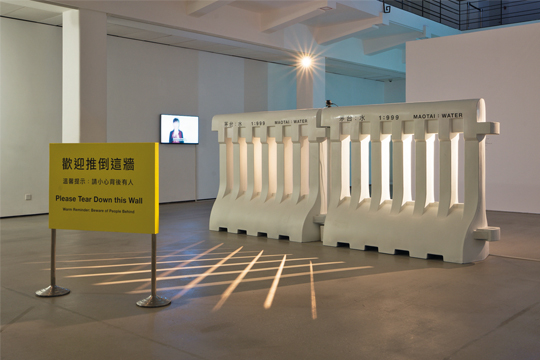2013 HUGO BOSS ASIA ART: AWARD FOR EMERGING CHINESE ARTISTS
| January 27, 2014 | Post In LEAP 24

(Maotai-Water, 1: 999)
Installation view, 2013
Rockbund Art Museum, Shanghai
The Hugo Boss Prize was founded in 1996. For its first two instances, in a move to better showcase the event, a group show of the nominees was organized at the Guggenheim; it wasn’t until the third that only the winning artist’s work was exhibited. The organizers of the Hugo Boss Asia Art award are taking care to follow in the footsteps of the successful brand: for the inaugural prize, an exhibition of seven nominated artists (and collectives) under 35 years of age, was held at the Rockbund before the prize winner was announced. Since the exhibition does not have an overall curatorial plan or authorial control, the interplay between the artists’ works lends a loose logic to it. This is especially clear where different artists share a space on the same floor.
Inside the entrance on the second floor is a narrow “hallway,” the walls filled with photographs by the collective Birdhead from their “Welcome Back to Birdhead World 2013 – Shanghai” exhibition. The sheer quantity makes it hard to discern their aesthetic qualities or the relationships between them—it is only possible to glance over them and absorb some fragmentary visual information. Li Liao is shown on the same floor, his work featuring tattered sweaters and broken remote controls in a small area accompanied by the sounds of an argument. This is a recording of an actual event: the fierce opposition of his girlfriend’s parents and family to her plans to marry Li. The work is titled Art is a Vacuum, and the subject is a classic one: the debate over what constitutes “basic human needs” between the artist in the “vacuum” and the “ordinary” person who wants a sense of security. However, it is very hard for us to view this random event from someone’s personal life as performance art, even if the recreation is more fascinating than the original event. To publicly display the “evidence” of the fight— to turn a private and hidden experience into a historical relic for everyone to reminisce about and revere—feels somewhat distasteful (a similar method is also evident in the artist’s other works here, Consumption and Illumination). The problem is, some of Li Liao’s artworks have been divided in two by Birdhead’s hallway—if you want to see them as one, you have to pass through a barrage of dizzying urban moments recorded at fast shutter speed. This creates a temporal confusion.
Sharing a space can be mutually beneficial. On the fourth floor is Li Wei’s I Am at Peace, bursting with portent of danger, and between the fourth and fifth floor she has mounted her bust of a mental patient. Several of Kwan Sheung Chi’s works are displayed in between hers, as if tracing the societal roots of her existential angst. It must be said, however, that although many people overlooked Lee Kit’s subtle alterations to the top floor coffee shop, his being able to occupy a whole floor is most suitable for displaying such a systematized artistic language and working method. An example is Hsu Chia-Wei’s work in the third floor space—through fieldwork and film, he explores the subject of geographical personal identity, in an impressive display of artistic skill. Hu Xiangqian, meanwhile, took the opportunity to put on a small-scale retrospective on the fifth floor.
As mentioned at the start of this review, the aim of this exhibition is to draw more attention to this new prize; it is the artists’ work in the long-term that forms the real basis of the judging criteria. To put it another way, the fact that Kwan Sheung Chi won the prize reminds us that the crucial factor in success is not “visibility” in the show—his original submission could not be included due to censorship by the cultural authorities; his work here lacks visual impact. his works delight in oscillating between the sharp political sentiment of leftwing Hong Kong intellectuals and bland descriptive language. They include: sheets of blank paper stacked to be 64 x 89 cm ( Untitled [White]); relaxed videos filmed in the kitchen offering instructions on how to make suicide and self-defense equipment (doing it with Chi…making an Exit Bag and doing it with Mrs Kwan…making Pepper Spray); and the pointless activity of shredding a string of thread (the video Breaking Up a Piece of Short Thread). It is a relatively safe move—an artistic language that makes art palatable by “avoiding the big issues by concentrating on the trivial”—the secret weapon of many an artist. Yet under the uniquely awkward conditions that we have here, such oblique forms of protest are perfectly reasonable.

